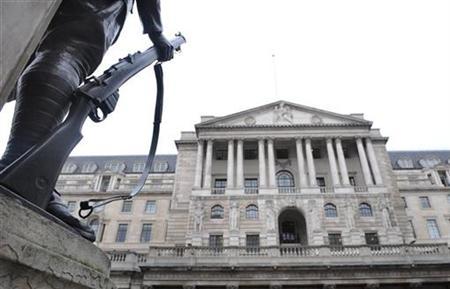The government and the Bank(sters) of England are intentionally ruining what is left of the economy and what is left of trust in the currency. Britain has become a worse credit risk than McDonald’s. The U.S. will fail and the U.K. is doing everything to follow suit. Who will pay for those billions of pounds? The government has to raise taxes or has to issue more bonds, which are nothing more than a promise to raise taxes in the future, because that money has to be paid back plus interest. Creating billions of pounds out of ‘thin air’ will further weaken the pound and will create massive inflation, which is nothing more than a ‘hidden tax’. The taxpayers will have to pay for all of it until the taxpayers will finally fail.
_________________________________________________________________________
Dec. 10 (Bloomberg) — The U.K. government and central bank are considering plans to pump billions of pounds into the economy as the bank rescue package and the lowest interest rates since 1951 fail to halt a slide into recession.
The Bank of England and the Treasury are weighing a strategy known as “quantitative easing” where authorities increase money supply to boost bank reserves. The initiative was last used by Japan at the start of the decade.
Prime Minister Gordon Brown’s government is frustrated that banks are rationing credit after tapping the Treasury for cash and guarantees to prop up their own balance sheets. Policy makers both in the U.K. and the U.S. Federal Reserve are looking beyond traditional interest-rate tools to revive the economy.
“The Bank of England has to step up to the plate,” said Neil Mackinnon, chief economist at ECU Group Plc in London. “They are thinking hard about quantitative easing. But they probably won’t announce anything until the next quarter, and they’ll follow the Fed.”
A U.K. Treasury spokesman said it is prudent for the government and the central bank to consider all options as the Bank of England’s benchmark lending rate approaches zero. He denied that a decision has been made and declined to be identified in line with government policy.
Darling’s Caution
Chancellor of the Exchequer Alistair Darling, asked about a report in the Guardian newspaper about the matter, appeared to be caught off guard and suggested that any step toward quantitative easing was over the horizon for the moment.
“It is no more than a report,” Darling told lawmakers on the Treasury Committee in Parliament. “It is something we’re not looking at, at the moment. Interest rates are at 2 percent. They have some way to fall. It’s not something people should get too excited about.”
The Bank of England cut the benchmark interest rate to 2 percent on Dec. 4, the lowest level since 1951 and down from 5 percent as recently as Oct. 7. Banks including HBOS Plc, Royal Bank of Scotland Plc and Lloyds TSB Group Plc that took bank rescue money have been reluctant to pass on those rate cuts.
The average cost of a two-year fixed-rate mortgage fell by 0.71 of a percentage point to 5.11 percent in November, the central bank said. That’s less than half the 1.5 point reduction the Bank of England delivered on its key rate on Nov. 6.
King’s View
Bank of England Governor Mervyn King has said officials at central banks around the globe were discussing their next steps and how to act as their benchmark lending rates near zero.
“At that point, there needs to be a close coordination between government and central bank because monetary policy is very close to debt management,” King told the same panel on Nov. 25. “But decision-making power as to what the bank would do would still rest with the Monetary Policy Committee.”
Darling said the Treasury would have to approve any Bank of England move toward quantitative easing and Parliament would need to be informed. He said he wasn’t sure whether lawmakers would have to approve the step, which traditionally has been a power of the chancellor.
On Dec. 4, the U.K. central bank suggested policy makers had more to do beyond lowering interest rates in their effort to bolster bank lending.
“The committee noted that it was unlikely that a normal volume of lending would be restored without further measures,” the central bank’s decision-making panel said in a statement accompanying its rate reduction.
Fed Move
Federal Reserve Chairman Ben S. Bernanke has also signaled he’s ready to use less conventional policies, such as buying Treasury securities, because his room to lower the main U.S. rate from the current 1 percent level is “obviously limited.”
Darling, while saying all options are open, suggested quantitative easing isn’t near the top of his agenda at the moment.
“The situation is full of uncertainties,” Darling said. “We will always be in a position where we will act as we need to. Interest rates are still 2 percent. We haven’t got to a position where they’re zero yet.”
To contact the reporter on this story: Gonzalo Vina in London at [email protected]
Last Updated: December 10, 2008 12:36 EST
By Gonzalo Vina
Source: Bloomberg

1 thought on “U.K. May Expand Toolkit to Halt Recession Slide”